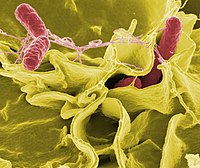
Photo from wikipedia
Abstract Mild heat treatment enhances the ability of microorganisms to endure subsequent heat treatment and other environmental stresses by initiating the heat shock response (HSR). This study was conducted to… Click to show full abstract
Abstract Mild heat treatment enhances the ability of microorganisms to endure subsequent heat treatment and other environmental stresses by initiating the heat shock response (HSR). This study was conducted to determine the thermal resistance of foodborne pathogens (Escherichia coli O157:H7, Salmonella enterica serovar Typhimurium, Listeria monocytogenes, Cronobacter sakazakii, and Staphylococcus aureus) after various heat shock treatments (HSTs) (50 °C for 30, 60, and 120 min) to subsequent thermal treatment at 60 °C and to investigate the mechanism for the HSR of S. Typhimurium by assessing cellular damage and morphological changes. Heat-shocked (HS) S. Typhimurium treated at 50 °C for 120 min showed the greatest resistance against subsequent heat treatment at 60 °C. Results revealed that HST caused less membrane damage and less heat-induced injury in the presence of metabolic inhibitors, compared with non-heat-shocked (non-HS) cells during thermal treatment. Furthermore, fluorescence microscopic images showed increased death, rather than sublethal injury, in non-HS cells, whereas HST induced mainly sublethal injury during thermal treatment. Analysis of electron micrographs showed that the cytoplasm was the main cellular component damaged by HST. Additionally, HST cross-protected S. Typhimurium against 15% ethanol and 25% NaCl, but not against pH 2.5, 0.01% H2O2, or -20 °C and it also enhanced thermal resistance in foods tested. Therefore, the ability of HS S. Typhimurium to tolerate subsequent thermal treatment and environmental stresses and its altered behavior should be considered when developing microbial control measures for food processing.
Journal Title: Food Control
Year Published: 2021
Link to full text (if available)
Share on Social Media: Sign Up to like & get
recommendations!